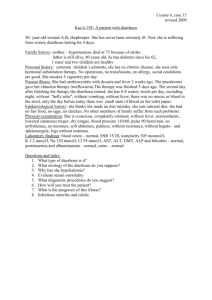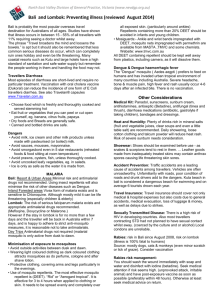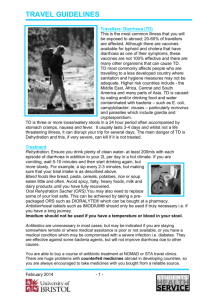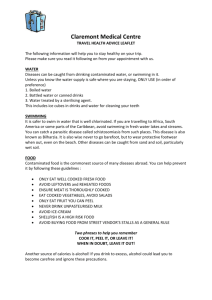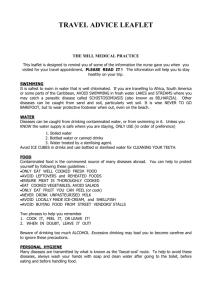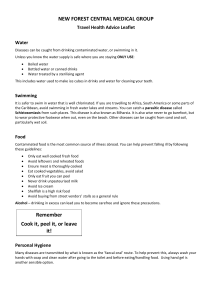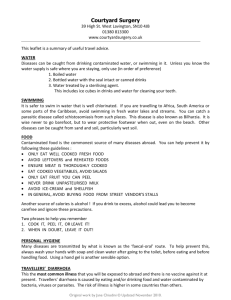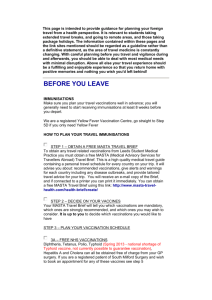Trekkers: Treatment information August 2012
advertisement
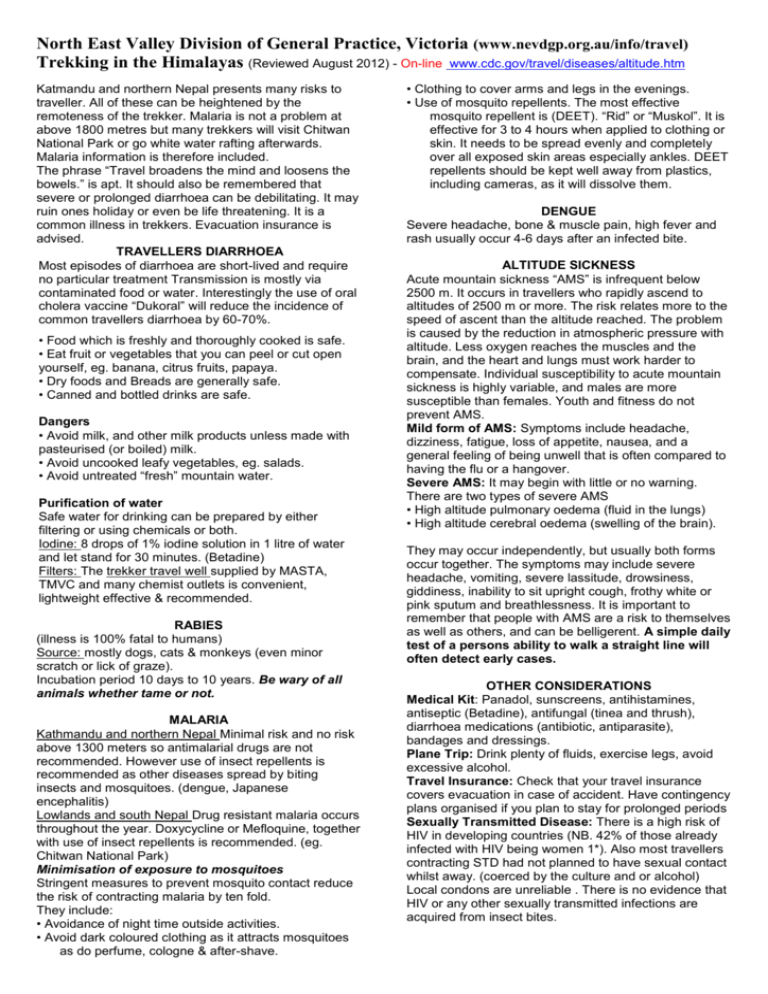
North East Valley Division of General Practice, Victoria (www.nevdgp.org.au/info/travel) Trekking in the Himalayas (Reviewed August 2012) - On-line www.cdc.gov/travel/diseases/altitude.htm Katmandu and northern Nepal presents many risks to traveller. All of these can be heightened by the remoteness of the trekker. Malaria is not a problem at above 1800 metres but many trekkers will visit Chitwan National Park or go white water rafting afterwards. Malaria information is therefore included. The phrase “Travel broadens the mind and loosens the bowels.” is apt. It should also be remembered that severe or prolonged diarrhoea can be debilitating. It may ruin ones holiday or even be life threatening. It is a common illness in trekkers. Evacuation insurance is advised. TRAVELLERS DIARRHOEA Most episodes of diarrhoea are short-lived and require no particular treatment Transmission is mostly via contaminated food or water. Interestingly the use of oral cholera vaccine “Dukoral” will reduce the incidence of common travellers diarrhoea by 60-70%. • Food which is freshly and thoroughly cooked is safe. • Eat fruit or vegetables that you can peel or cut open yourself, eg. banana, citrus fruits, papaya. • Dry foods and Breads are generally safe. • Canned and bottled drinks are safe. Dangers • Avoid milk, and other milk products unless made with pasteurised (or boiled) milk. • Avoid uncooked leafy vegetables, eg. salads. • Avoid untreated “fresh” mountain water. Purification of water Safe water for drinking can be prepared by either filtering or using chemicals or both. Iodine: 8 drops of 1% iodine solution in 1 litre of water and let stand for 30 minutes. (Betadine) Filters: The trekker travel well supplied by MASTA, TMVC and many chemist outlets is convenient, lightweight effective & recommended. RABIES (illness is 100% fatal to humans) Source: mostly dogs, cats & monkeys (even minor scratch or lick of graze). Incubation period 10 days to 10 years. Be wary of all animals whether tame or not. MALARIA Kathmandu and northern Nepal Minimal risk and no risk above 1300 meters so antimalarial drugs are not recommended. However use of insect repellents is recommended as other diseases spread by biting insects and mosquitoes. (dengue, Japanese encephalitis) Lowlands and south Nepal Drug resistant malaria occurs throughout the year. Doxycycline or Mefloquine, together with use of insect repellents is recommended. (eg. Chitwan National Park) Minimisation of exposure to mosquitoes Stringent measures to prevent mosquito contact reduce the risk of contracting malaria by ten fold. They include: • Avoidance of night time outside activities. • Avoid dark coloured clothing as it attracts mosquitoes as do perfume, cologne & after-shave. • Clothing to cover arms and legs in the evenings. • Use of mosquito repellents. The most effective mosquito repellent is (DEET). “Rid” or “Muskol”. It is effective for 3 to 4 hours when applied to clothing or skin. It needs to be spread evenly and completely over all exposed skin areas especially ankles. DEET repellents should be kept well away from plastics, including cameras, as it will dissolve them. DENGUE Severe headache, bone & muscle pain, high fever and rash usually occur 4-6 days after an infected bite. ALTITUDE SICKNESS Acute mountain sickness “AMS” is infrequent below 2500 m. It occurs in travellers who rapidly ascend to altitudes of 2500 m or more. The risk relates more to the speed of ascent than the altitude reached. The problem is caused by the reduction in atmospheric pressure with altitude. Less oxygen reaches the muscles and the brain, and the heart and lungs must work harder to compensate. Individual susceptibility to acute mountain sickness is highly variable, and males are more susceptible than females. Youth and fitness do not prevent AMS. Mild form of AMS: Symptoms include headache, dizziness, fatigue, loss of appetite, nausea, and a general feeling of being unwell that is often compared to having the flu or a hangover. Severe AMS: It may begin with little or no warning. There are two types of severe AMS • High altitude pulmonary oedema (fluid in the lungs) • High altitude cerebral oedema (swelling of the brain). They may occur independently, but usually both forms occur together. The symptoms may include severe headache, vomiting, severe lassitude, drowsiness, giddiness, inability to sit upright cough, frothy white or pink sputum and breathlessness. It is important to remember that people with AMS are a risk to themselves as well as others, and can be belligerent. A simple daily test of a persons ability to walk a straight line will often detect early cases. OTHER CONSIDERATIONS Medical Kit: Panadol, sunscreens, antihistamines, antiseptic (Betadine), antifungal (tinea and thrush), diarrhoea medications (antibiotic, antiparasite), bandages and dressings. Plane Trip: Drink plenty of fluids, exercise legs, avoid excessive alcohol. Travel Insurance: Check that your travel insurance covers evacuation in case of accident. Have contingency plans organised if you plan to stay for prolonged periods Sexually Transmitted Disease: There is a high risk of HIV in developing countries (NB. 42% of those already infected with HIV being women 1*). Also most travellers contracting STD had not planned to have sexual contact whilst away. (coerced by the culture and or alcohol) Local condons are unreliable . There is no evidence that HIV or any other sexually transmitted infections are acquired from insect bites. Trekkers: Treatment information August 2012 MANAGEMENT OF DIARRHOEA Antimotility drugs (‘stoppers’). Since most diarrhoeal illnesses last only a few days, these drugs may be very helpful in relieving diarrhoea and cramps. Do not use if high fever or blood in motions. Adult Dosage: loperamide -2 capsules (each 2 mg) followed by 1 cap after each unformed stool. (maximum 8 caps per day.) Antibiotics. Diarrhoea with high fever, distressing symptoms or blood in motions: eg (single dose Norfloxacin 800mg, Ciproxin 1Gm or Azithromycin 1 Gm ). Nb Azithromycin safe for children >12 months and in pregnancy. When diarrhoea is prolonged and without fever a bowel parasite “giardiasis” is the commonest cause. The best treatment is tinidasole (Fasigyn) - 4 x 500mg tablets (2g) in a single dose. Metronidazole 400mg three times a day for 5 days is an alternative. If this is not completely effective amoebic dysentery is a possibility. Treatment is (Fasigyn) - 4 x 500mg tablets (2g) daily for 3 days. PREVENTION OF ACUTE MOUNTAIN SICKNESS Acclimatisation should be achieved at an altitude between 1500 and 2500 m for 2-4 days before ascending to a higher elevation. Once above 3000 m particular care should be taken not to increase the sleeping altitude by more than 300 m per day, and to spend an extra day for each 1000 m gained. The body’s water losses increase during an active day in the dry cold air at high altitude, therefore, fluid intake should be increased (you may need as much as 4-7 litres per day). Drugs to prevent AMS often only hide the warning symptoms. However drugs may be useful in selected individuals, such as those known to be at risk. Acetazolamide (Diamox) Diamox 250 mg tablets(1/4 up to 1 tablet) given twice a day commencing one or 2 days before the ascent to altitude above 2500 m and continued for at least 5 days. Side effects are common and include paraesthesia (tingling sensation in fingers and toes), bowel disturbances, sleepiness and increased urine volume. Acetazolamide should not be taken by individuals who are allergic to sulpha drugs. Spironolactone (Aldactone) 25mg 4 times a day , is an alternative. Salmeterol inhaler: (Serevent, Oxis) 125mg inhaled 12 hourly starting the day before ascent has recently been shown to be useful in preventing HAPE. It should be used in conjunction with Acetazolamide. Dexamethasone: For most travelers, the best way to avoid altitude illness is by gradual ascent, with extra rest days at intermediate altitudes every 3,000 ft (900 m) or less. Dexamethasone and pulmonary artery pressurelowering drugs, such as nifedipine or sildenafil, may be carried for emergencies. RABIES Post-exposure immunisation You should wash the wound immediately with soap and water and then disinfect with iodine (betadine). Seek medical attention if risk seems high. (Unprovoked attack, irritable animal) and have post-exposure vaccine as soon as possible (preferably within 48 hours). Otherwise at least seek medical advice on return. MALARIA Malaria is spread by the bite of Anopheles mosquito, which is active between dusk and dawn. Malarial symptoms can occur after 8 days following an infected bite. The classic symptoms are fever, malaise, headache, chills and sweats. Early diagnosis and treatment of malaria Any fever developing after 8 days may be due to malaria. You should consult a doctor, and ask for a malarial thick blood film to be done. You should do so within 48 hours of onset of fever, or earlier if you are more than moderately unwell. Antimalarial Drugs: Prevention All should be taken for 4 weeks on leaving malarial risk area. Common side effects Doxycycline These include thrush, stomach & bowel upsets, (particularly if medication is taken on an empty stomach) and sunlight sensitivity. This can minimised by avoidance of sunlight, using sunscreen and taking the drug in the evening. Drinking copious quantities of water is recommended to reduce heartburn. Mefloquine (‘Lariam’) Minor side effects such as nausea, vomiting, heartburn and loose stools occur in about 20% of users, but this is no more frequent than with other antimalarials and usually subside with continued use. Taking ½ tab twice a week and drinking copius water with medication will help reduce these. Unfortunately mefloquine can produce annoying side effects such as insomnia, vivid dreams, dizziness, mental clouding, anxiety and even co-ordination problems in up to 10% of users. These are probably aggravated by use of alcohol and cannabis particularly if taken on the same day of medication. Pregnancy should be avoided for 3 months after use of mefloquine. Malaria:- Stand by Treatment If medical treatment not available, A new drug combination Malarone (Atovaquone + Proguanil) is now available as a standby treatment. It is highly effective even in border areas of Thailand. The dosage is 4 tabs daily for 3 days with food and is now considered the drug of choice. Combined with the very sensitive falciparum malaria skin prick test (available from MASTA & TMVC centres) is an essential tool for those travelling to remote areas. A finger prick blood sample gives a result in 5 minutes. For Plasmodium falciparum infection the test is close to 100% reliable in experienced hands. and is stable at 37 degrees C for 4 months. The reliability of this test for use by a febrile, trembling & delirious traveller with no previous training limits its use. Medical Examination after travel: It is advisable (if not essential) to visit your local doctor promptly if your child • develops fever, diarrhoea, vomiting, urinary or skin disorder in the weeks following return • have had a significant illness whilst away • have spent a long time abroad Further Weblinks for information CDC Travelplanner: http://www.cdc.gov/travel/ WHO year book 2012 - www.who.int/ith/index.html Australian Consular advice www.dfat.gov.au/consular/advice/advices_mnu.html Travel apps for iphone – www.travellingwell.com.au
